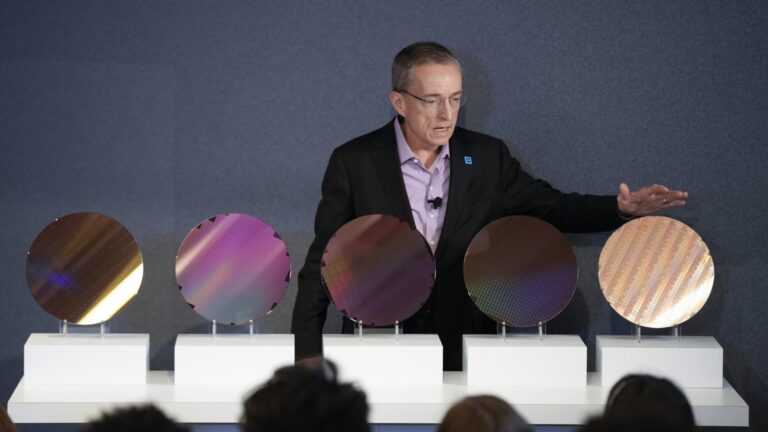Intel CEO Pat Gelsinger speaks while showing silicon wafers during an event called AI Everywhere in New York, Thursday, Dec. 14, 2023.
Seth Wenig | AP
Intel’s long-awaited turnaround looks farther away than ever after the company reported dismal first-quarter earnings. Investors pushed the shares down 9% on Friday to their lowest level of the year.
Although Intel’s revenue is no longer shrinking and the company remains the biggest maker of processors that power PCs and laptops, sales in the first quarter trailed estimates. Intel also gave a soft forecast for the second quarter, suggesting weak demand.
It was a tough showing for CEO Pat Gelsinger, who’s early in his fourth year at the helm.
But Intel’s problems are decades in the making.
Before Gelsinger returned to the company in 2021, the company, once synonymous with “Silicon Valley,” had lost its edge in semiconductor manufacturing to overseas rivals like Taiwan Semiconductor Manufacturing Co. Now, in a high-risk quest, it’s spending billions per quarter to regain ground.
“Job number one was to accelerate our efforts to close the technology gap that was created by over a decade of underinvestment,” Gelsinger told investors on Thursday. He said the company is still on track to catch up by 2026.
Investors remain skeptical. Intel is the worst-performing tech stock in the S&P 500 this year, down 37%. Meanwhile, the two best-performing stocks in the index are chipmaker Nvidia and Super Micro Computer, which has been boosted by surging demand for Nvidia-based artificial intelligence servers.
Intel, long the most valuable U.S. chipmaker, is now one-sixteenth the size of Nvidia by market cap. It’s also smaller than Qualcomm, Broadcom, Texas Instruments, and AMD. For decades, it was the largest semiconductor company in the world by sales, but suffered seven straight quarters of revenue declines recently, and was passed by Nvidia last year.
Gelsinger is betting on a risky business model change. Not only will Intel make its own branded processors, but it will act as a factory for other chip companies that outsource their manufacturing — a group of companies that includes Nvidia, Apple, and Qualcomm. Its success acquiring customers will depend on Intel regaining “process leadership,” as the company calls it.
Other semiconductor companies would like an alternative to TSMC so they don’t have to rely on a single supplier. U.S. political leaders including President Biden call Intel an American chip champion and say the company is strategically an important part of the U.S. processor supply chain.
“Intel is a big, iconic semiconductor company which has been the leader for many years,” said Nicholas Brathwaite, managing partner at Celesta Capital, which invests in semiconductor companies. “And I think it’s a company that is worth trying to save, and they have to come back to competitiveness.”
But the chipmaker isn’t doing itself any favors.
“I think everyone has been hearing them say the next quarter will be better for…
Read More: U.S. chipmaker Intel was once dominant, now struggles to stay relevant



